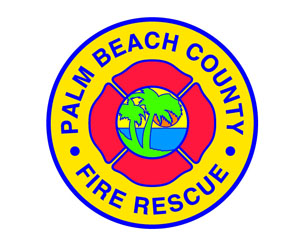Palm Beach County Fire-Rescue is already spending more than the agency is taking in, but the Palm Beach County Commission asked county staff and fire-rescue brass Tuesday to find a way to return emergency response vehicles to a complement of three personnel.
In some areas, emergency vehicles are now being run with two PBCFR staff members as a cost-saving measure.
At the start of his report, PBCFR Chief Steve Jerauld said that the budget assumptions he would give were just snapshots.
“The assumptions that we made, the facts that we used, are very fluid and subject to change,” Jerauld said, explaining that the municipal service taxing unit (MSTU) funding process is identical to the method the county uses.
He said 81 percent of the PBCFR budget goes to personal services, therefore the collective bargaining unit needs to be part of the contribution to cost reduction.
For the first time in 2011, fire-rescue spending outpaced revenue, with $234 million in spending and $228 million in revenue.
“We spent $6.4 million more than we took in,” Jerauld said. “For 2012, we believe we will close with an even greater deficit. We’re estimating about $12 million for 2012, and for 2013, we believe that gap will grow.”
Currently, the difference is being made up by drawing from reserves. He projected that PBCFR’s anticipated year-end fund balance of 27 percent, or $88 million for 2013, would be down to 18 percent by 2015, which was within the county’s recommended reserve range of 15 to 20 percent.
County Administrator Bob Weisman pointed out that the biggest factors in the fire-rescue spending plan were pretty much laid out. “We’ve not projected any pay increases for the employees,” he said. “The state numbers for the Florida Retirement System contributions, those are probably the biggest factors, those are dictated, so that’s not debatable.”
Jerauld said about 80 percent of the department’s financing comes from ad valorem taxes.
He said 102 vacant firefighter positions have been deleted and many of the vacancies are being filled by paying overtime, which is currently saving about $7.7 million. Jerauld added that the reserves for the main MSTU will drop to about $58 million for 2013. “If we were to reinstate the staffing for next year, the reserves would be reduced by $10 million,” he said.
Commissioner Priscilla Taylor said there has been a lot of talk about cutting staffing to two personnel to a truck, rather than three as used in areas with heavier activity. Jerauld said 21 of the 46 trucks have long been run with two personnel. Of the remaining 26 units, 18 trucks have run with two since April.
“That’s a concern that I have,” Taylor said, who asked Jerauld whether the deletion of the 102 positions was what drove the change. Jerauld said it was, but that reinstating the positions would also deplete his reserves more quickly.
Weisman said by deleting the positions, the overtime is needed in order to staff the three persons per rescue. “The decision was made to not incur that overtime, and not staff those units when there were not people available,” he said.
Commissioner Karen Marcus said the commissioners adopted the policy of three men on a truck several years ago. “That’s a national standard,” she said.
Jerauld said that prior to April, he was staffing with three men on a truck by paying overtime, which was slightly cheaper than filling the 102 vacancies. “It’s going to have a significant impact on future budgets,” he said.
Commissioner Burt Aaronson said he felt three on a truck was desirable for maximum efficiency on emergency calls. “For the safety of the people, cutting back to two people on a truck is not something that I want to do,” Aaronson said, explaining that he had learned the effectiveness of the three-person team. “If you eliminate any one of those three, in my opinion, it puts the life of a resident that we all represent in jeopardy.”
Aaronson said he wanted to go over the budget thoroughly and find ways to keep three people on the trucks.
Taylor said she definitely supported three on a truck without raising the tax rate. She also asked that staff bring back more specific numbers for staffing that with full-time personnel as opposed to paying overtime. “None of us want to see the millage increased,” she said.
Commission Vice Chairman Steve Abrams said they also need to get the final accounting report, which will not be available until the July property values are released.
Commissioner Jess Santamaria said safety is the No. 1 priority but that he was strongly opposed to overtime as a policy.
“The only time to have overtime is during a major disaster,” Santamaria said. “Someone working a 40-hour shift is more efficient.”








